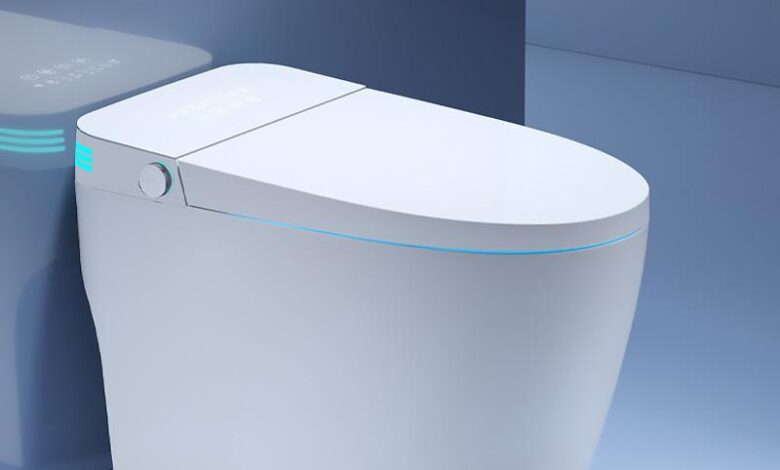Comparing Rimless to Rimmed Toilets: Performance and Design Differences

When renovating or designing a bathroom, one of the most important decisions you’ll make is choosing the right toilet. Among the many types available, rimless toilets and traditional rimmed toilets are two of the most popular options.
This article provides a comparative analysis of the rimless toilet and its traditional counterpart, helping you understand their design differences and performance characteristics to choose the best option for your home.
What Are Rimless Toilets?
A rimless toilet, also known as rimless commode, is a modern toilet design that eliminates the traditional rim around the inside of the toilet bowl. This design allows for a more efficient and powerful flush, as water is directly released into the bowl from the back, rinsing it clean without the need for a rim to disperse the water, says BridgeHaus Property Managers team.
Pros of Rimless Toilets:
- No Rim: The absence of the traditional rim helps with cleaning and ensures more even water distribution during a flush.
- Better Hygiene: The smooth design reduces places where bacteria and grime can accumulate.
- Efficient Flushing: Water flows directly into the bowl at a high pressure, making for a stronger, more effective flush.
Cons of rimless toilets:
- Higher initial cost: Because of their advanced design and technology, rimless commodes tend to be more expensive than traditional toilets.
- More complex installation: The installation process of rimless toilet can also be more complex, as the high-pressure flush may require professional plumbing adjustments or modifications to your existing plumbing system.
Understanding these rimless toilet pros and cons will help you decide if the investment aligns with your bathroom needs and budget.
What Are Traditional Rimmed Toilets?
Traditional rimmed toilets, which have been around for decades, feature a water tank located at the back of the toilet bowl with a rim around the edge of the bowl. Water flows from the tank and is dispersed through holes in the rim to rinse the bowl.
While rimmed toilets have a proven track record of reliability, they are generally less efficient when it comes to water distribution and cleaning.
The rim on traditional toilets can trap dirt, limescale, and bacteria, which makes cleaning more difficult and time-consuming. Additionally, some areas of the bowl may not be properly rinsed during the flush, which could lead to unpleasant odors or lingering waste.
Key Features of Traditional Rimmed Toilets:
- Gravity-Based Flushing: Water flows over the rim into the bowl using gravity, but it’s often not as powerful or efficient as the pressure-assisted flush of rimless toilets.
- Harder to Clean: The rim creates hidden areas that can accumulate dirt, making it harder to maintain cleanliness.
- Water Distribution: Water is dispersed over the rim, which may not clean the entire bowl thoroughly.
Flushing Efficiency: Rimless vs. Traditional Rimmed Toilets
Rimless Toilets: Superior Flushing Power
One of the most important factors to consider when comparing rimless toilets to traditional rimmed models is flushing efficiency. Rimless toilets have a significant edge in this category. They typically use a high-pressure, direct-flush system that ensures waste is quickly and thoroughly removed.
Water is delivered directly into the bowl, often in a rimless tornado toilet bowl design, where the water is swirled around the entire bowl, ensuring every surface is cleaned effectively with minimal water.
The rimless WC design also maximizes the power of the flush, providing a faster and more efficient waste removal system, reducing the chances of clogs or multiple flushes. Because the design focuses on directing the water to all areas of the bowl, rimless toilets tend to require less water per flush compared to traditional toilets, making them more eco-friendly.
Traditional Rimmed Toilets: Gravity-Fed Flush
On the other hand, traditional rimmed toilets rely on gravity to disperse water from the tank, which flows over the rim to clean the bowl. While effective, this system often doesn’t provide the same level of power as the pressure-assisted system in rimless toilets.
Gravity-fed systems can leave certain areas of the bowl uncleaned, leading to waste accumulation or stains. In addition, traditional rimmed toilets tend to use more water per flush compared to rimless toilets, which could contribute to higher water bills over time.
Conclusion on Flushing Efficiency
When it comes to flushing efficiency, rimless toilets have a clear advantage over traditional rimmed models. The direct, high-pressure flush of a rimless commode ensures thorough cleaning, less water usage, and more efficient waste removal.
Ease of Cleaning: Rimless vs. Traditional Rimmed Toilets
Rimless Toilets: Easier to Clean
One of the standout features of rimless toilets is how easy they are to clean. Since there’s no rim to trap dirt, limescale, or bacteria, cleaning a rimless toilet bowl is much simpler.
The open design of a rimless bowl toilet means you can easily wipe down the entire surface of the bowl without the need for special cleaning tools. The smooth, rimless design also reduces the chance of grime buildup in hard-to-reach areas, making it much more hygienic.
Many rimless tornado toilet bowls are also designed with smooth, rounded edges, reducing the surface area where dirt can collect. This means less time spent cleaning and more peace of mind when it comes to maintaining hygiene.
Traditional Rimmed Toilets: Harder to Clean
In contrast, traditional rimmed toilets can be more difficult to clean due to the rim. Over time, dirt and grime accumulate in the rim, which requires extra effort to scrub and disinfect.
The water flow from the tank doesn’t always reach the entire bowl, which can result in areas being missed during the flush. Cleaning these areas can be frustrating and may require the use of a toilet brush or special cleaning solutions.
Additionally, the underside of the toilet seat in traditional rimmed toilets can also accumulate bacteria and stains, making it harder to keep the entire toilet hygienic. Regular cleaning is necessary to ensure these toilets remain in good condition.
Conclusion on Cleaning
For ease of cleaning, rimless toilets offer a clear advantage. The design eliminates the hard-to-reach rim, making it much easier to keep your toilet clean and hygienic with minimal effort. Rimless commodes are ideal for homeowners who want a low-maintenance, easy-to-clean toilet.
Overall Performance: Rimless vs. Traditional Rimmed Toilets
Rimless Toilets: Superior Hygiene and Modern Design
Rimless toilets offer superior overall performance due to their modern design, efficient flushing system, and ease of maintenance. The rimless toilet bowl provides better water distribution and faster, more effective waste removal.
Rimless toilets also tend to be more eco-friendly, using less water per flush while maintaining strong flushing power. In terms of hygiene, the rimless tornado toilet bowl design helps eliminate areas where bacteria and grime can collect, keeping your bathroom cleaner for longer.
Moreover, the rimless WC often features a sleek and contemporary design that fits well in modern bathrooms, adding both style and functionality. If you prioritize performance, hygiene, and ease of maintenance, rimless toilets are the best choice.
Traditional Rimmed Toilets: Reliable but Less Efficient
While traditional rimmed toilets are reliable and affordable, their performance lags behind that of rimless toilets. They may not provide the same level of flushing efficiency, and their design makes them harder to clean.
However, traditional rimmed toilets are still widely used due to their affordability and proven effectiveness. For many homeowners, rimmed toilets remain the go-to option for bathrooms where cost and simplicity are the primary concerns.
Conclusion on Overall Performance
Rimless toilets outperform traditional rimmed toilets in terms of flushing efficiency, ease of cleaning, and overall hygiene. The advanced design and improved flushing systems make rimless toilets a more modern, effective choice for those seeking optimal performance and convenience.
Which Toilet Is Right for You?
Choosing between a rimless toilet and a traditional rimmed toilet depends on your priorities, budget, and bathroom design.
Choose a Rimless Toilet if:
- You want a modern, sleek design.
- You prioritize hygiene and easy cleaning.
- You prefer high-performance flushing with water savings.
- You’re willing to invest in a higher-end, eco-friendly toilet.
Choose a Traditional Rimmed Toilet if:
- You’re looking for a reliable, budget-friendly option.
- You’re comfortable with regular cleaning and maintenance.
- You prefer a proven, traditional flushing system.
- You need a more affordable, widely available option.
Final Thoughts
Both rimless toilets and traditional rimmed toilets have their advantages, and the right choice depends on your bathroom needs and preferences. If you value efficiency, modern design, and ease of maintenance, a rimless toilet is likely the better option. However, if you are on a budget or prefer a more traditional, familiar design, a rimmed toilet may still be the ideal choice.




